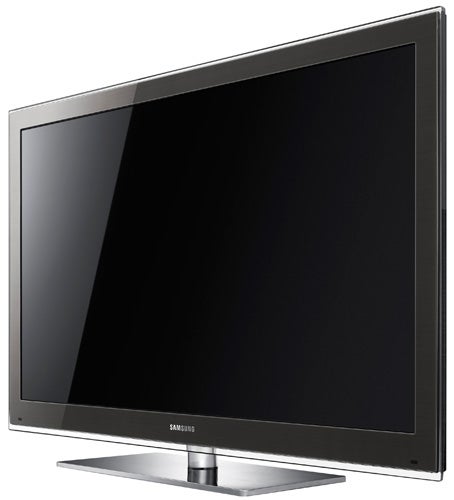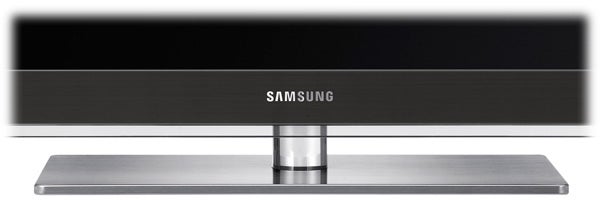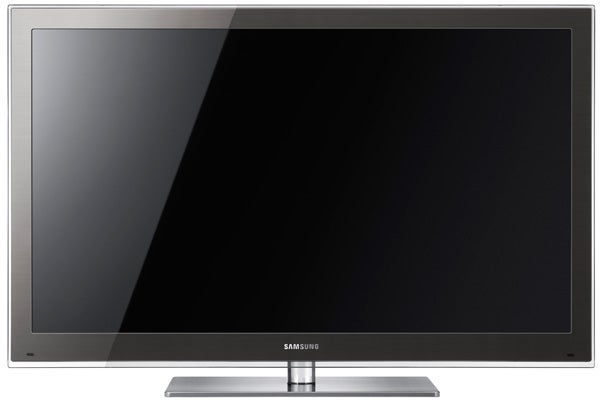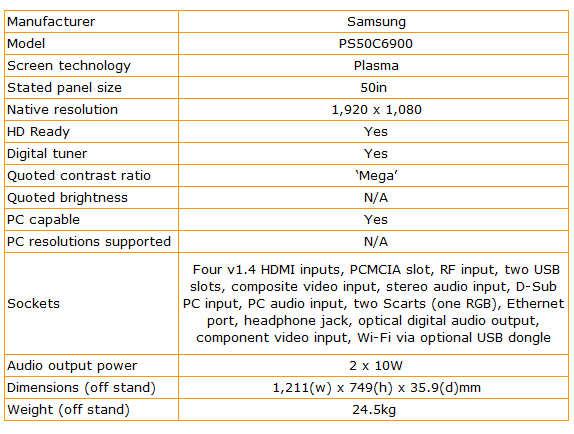Samsung PS50C6900 Review
Samsung PS50C6900
The first big-screen TV that makes alternate frame 3D both truly watchable and truly affordable all at the same time.

Verdict
Pros
- No motion blur, excellent viewing abgles
- Elegant design
- Less 3D crosstalk than rivals
Cons
- Average contrast
- Soft SD pictures
Key Specifications
- Review Price: £1010.00
- 3D shutter glasses included
- 4 HDMI ports
- Samsung Internet@TV platform
- 50-inch 1080p panel
- Freeview HD tuner
Aside from the simple issue of how many people really want 3D TV in their homes, three problems have undermined 3D’s 2010 debut. First, the number of full HD 3D Blu-rays coming out has been lower than expected. Second, the TVs capable of playing alternate-frame HD 3D have consistently been very expensive. And third, all the alternate frame LCD 3D TVs we’ve seen to date have suffered with distracting crosstalk (double ghosting) noise.
Despite – or maybe because of – all this, it’s actually with a high level of excitement that we take receipt of Samsung’s PS50C6900. For while this 50in TV clearly can’t end the 3D Blu-ray drought, its remarkably low price tag of £1,010 and use of plasma rather than LCD technology certainly raise hopes that it will be able to conquer the other two big 3D objections.
Let’s focus on that price a bit more. Basically, £1,010 would look pretty darned cheap for an ordinary 50in TV, yet here we’ve got one with full HD 3D support – complete with a built-in 3D transmitter and one pair of 3D active shutter glasses (worth around £100) thrown in for free. What’s more, the 3D capabilities are just the tip of a surprisingly large feature iceberg.
As for the fact that the PS50C6900 uses plasma technology, this is significant because the only 3D TVs we’ve seen that broadly avoid the dreaded crosstalk noise have been Panasonic’s plasma 3D models.
As well as the anticipation built by the factors we’ve just covered, the PS50C6900 builds on its instant ‘shelf appeal’ with a surprisingly pretty design. The single most striking thing about this is how slender the screen is – a surprising discovery given that the screen is a) so cheap and b) equipped with plasma rather than edge LED technology. We’re also fans of the cute grey colour used for the bezel – especially since this is offset so elegantly by a see-through outer trim.
Expectations that the PS50C6900 might have compromised its connectivity in its quest for cheapness are quickly shot down by even a cursory glance at the wealth of jacks on offer. Among the highlights are four HDMIs, two USBs, a D-Sub PC jack, and LAN port: everything, in other words, that we’d expect to find on a much more expensive TV.
What’s more, the USB and LAN ports just mentioned are all put to impressively wide-ranging use. First, the USBs are able to handle pretty much all the main video, photo and music file formats. Second, the USBs can be used to timeshift stuff – with no loss of quality – from the TV’s Freeview HD tuner to USB HDDs. Third, you can use an optional extra dongle in one of the USB ports to make the TV Wi-Fi capable. Fourth, the set’s LAN port can be used to stream files from networked DLNA PCs if you don’t pay extra to go Wi-Fi. And finally, the LAN port can be used to access Samsung’s online Internet@TV platform.
This platform has gone from a good, Widgets-exclusive start through a bit of a lull, back to being one of the best around again. In its latest form, it offers an impressive array of ring-fenced content, including streaming from LoveFilm, YouTube, Twitter, Facebook, and perhaps best of all, the BBC iPlayer.
The interface for all this content – plus a range of games and less interesting mini ‘apps’ – is a bit cumbersome, and we personally would like Samsung to add open Internet access to proceedings. But it’s still probably the second-best online system around right now, running a close second to Sony’s Bravia Internet Video platform.
Investigating the PS50C6900’s spec sheet more closely, meanwhile, reveals that it’s got the increasingly de rigueur ‘600Hz’ sub-field drive system (actually a system that pulses each plasma cell 10-12 times per second) for reducing judder and boosting colour intensity. It’s also a full HD resolution screen, as we would expect, and boasts one of those marvellously vague ‘Mega’ contrast performances Samsung likes to talk about these days.
This screen lacks the extra black filter sported by its step-up C7000 sibling (which costs around £250 more). But hopefully we won’t feel the loss of this reflection-reducing, contrast-boosting filter too keenly.
The last thing to discuss before finding out if our hopes for the PS50C6900’s 3D pictures are justified is the impressive suite of picture fine tuning adjustments contained within its onscreen menus. There’s an extensive amount of colour management, for instance, including being able to manipulate the gain and offset levels of the red, green and blue picture elements, and 10-point white balance adjustments.
As well as a standard brightness adjustment, moreover, you can adjust the screen’s Cell Light output for extra gamma control beyond the series of gamma presets the TV carries.
There are far more features too, from contrast boosters to edge enhancers, making us wonder why Samsung hasn’t followed the lead of its LG and Panasonic rivals in seeking endorsement from the ISF and, perhaps, THX.
The testing stage for the PS50C6900 has to begin with its 3D talents. And happily they don’t let us down. For it’s immediately clear that the PS50C6900 suffers far less with crosstalk noise than any other Samsung 3D TV seen to date – including the vastly more expensive C8000 and C9000 edge LED models.
Not seeing the edges of sharply defined 3D objects blighted by double ghosting as often or as badly as with any LCD 3D TV reaffirms plasma’s apparent advantage in this key area,. Plus, of course, it makes 3D much more engaging and credible, and much less tiring during long-term viewing. In other words, the PS50C6900’s lack of crosstalk merely underlines our impression of how damaging the problem is to other screens.
It should be added here that the PS50C6900 is actually slightly less immune to crosstalk noise than Panasonic’s 3D plasma TVs, making us suspect that it doesn’t use an equivalent of the fast-decay technology Panasonic has developed for its 3D screens. But the still-low levels of crosstalk it shows seem to us entirely tolerable given the TV’s extraordinarily low price.
The PS50C6900’s 3D pictures are slightly brighter than Panasonic’s, meaning that it arguably delivers a little more colour punch and shadow detail. However, before we get too excited about this, the screen can’t produce as profound a black level as Panasonic’s screens. A downside of which is that 3D pictures don’t tend to appear quite so full of depth or convincing during dark scenes as Panasonic’s.
Taking Samsung’s reasonably comfortable and effective 3D glasses off and switching to 2D material emphasises the slight black level shortcomings noted before. For without the darkening effect of the shuttering glasses, it’s apparent that there’s a sheen of greyness over black colours that you just don’t get with Panasonic’s sets – or, at least, that you don’t get with sets from the middle G20/GT20) upwards of Panasonic’s range.
Another issue we have with the PS50C6900’s 2D pictures is that they’re not particularly comfortable with standard definition material, leaving all but the most pristine of standard def sources looking rather soft. You get the odd quirky looking colour tone with standard def material, too.
Thankfully, though, the PS50C6900 really shifts through the gears with HD pictures. The softness evaporates and turns into some excellent sharpness and detailing, while colours look more natural and subtle across the board. More subtle shading in dark areas hides the set’s slight black level shortcomings to some extent too, making HD pictures look more dynamic and rich.
Also with HD pictures, you can really get a sense of how decent the PS50C6900’s motion handling is for such a cheap screen. There actually seems less judder with 50Hz sources, in fact, than you get with Panasonic’s sets. And there’s not a sign of the motion blur so common with LCD TVs.
You can also watch the PS50C6900 from almost any angle without it losing colour saturation or contrast, unlike the vast majority of LCD TVs.
As well as its mostly impressive pictures, the PS50C6900 proves a surprisingly decent audio performer. There’s still a problematic shortage of bass, and the soundstage can’t really open up to immersive levels when required to by a thumping action scene. But the soundstage is more rounded, dynamic and clean than you get with Samsung’s edge LED TVs.
Verdict
With interest in 3D arguably slightly waning as we head into Christmas (especially with Panasonic keeping the ”Avatar” 3D Blu-ray off the streets while it bundles it exclusively with its TVs and Blu-ray packages), the PS50C6900 couldn’t have arrived at a better time. Sure, Panasonic’s 3D screens still outperform it with 2D and 3D, and it will be interesting to see how much of a difference the black filter in Samsung’s C7000 plasma screens makes. But the headline-grabbing bottom line with the PS50C6900 is that it’s the first big-screen TV that makes alternate frame 3D both truly watchable and truly affordable all at the same time.

How we test televisions
We test every TV we review thoroughly over an extended period of time. We use industry standard tests to compare features properly. We’ll always tell you what we find. We never, ever, accept money to review a product.
Trusted Score
Score in detail
-
Features 9
-
3D Quality 9
-
Value 10
-
Design 9
-
2D Quality 8
-
Sound Quality 7
Features
| Size (Inch) | 50in, in |
| Display Type | Plasma |
| Max. Resolution | 1920 x 1080 |
| Digital Tuner | DVB-T (MPEG4), DVB-C (MPEG4) |
| 3D Ready | Yes |
| Refresh Rate (Hertz) | 50Hz |
Connectivity
| HDMI | 1.4 |
Physical Specifications
| Height (Millimeter) | 809mm, 59.6mm |
| Width (Millimeter) | 277mm, 103mm |
| Depth (Millimeter) | 36mm |
| Weight (Gram) | 24.50g |

